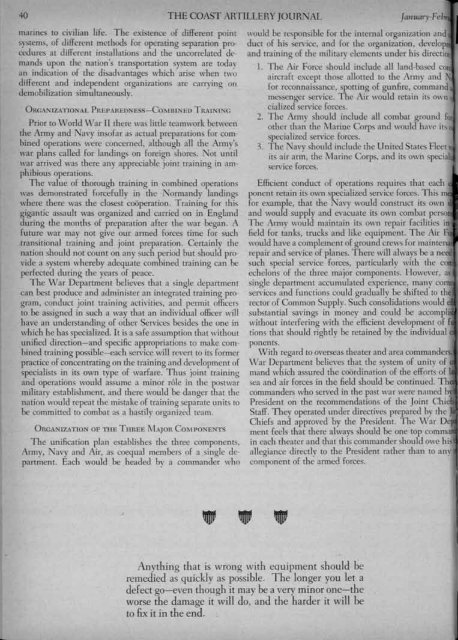January-February - Air Defense Artillery
January-February - Air Defense Artillery
January-February - Air Defense Artillery
Create successful ePaper yourself
Turn your PDF publications into a flip-book with our unique Google optimized e-Paper software.
40<br />
marines to ci\'ilian life. The existence of different point<br />
systems, of different methods for operating separation procedures<br />
at different installations and the uncorrelated demands<br />
upon the nation's transportation system are today<br />
an indication of the disadvantages which arise when two<br />
different and independent oroanizations are carrvino on<br />
o . 0<br />
demobilization simultaneouslv.<br />
ORGAl''lZATIONAL PREPAREDNESS-CoMBINED TRAINING<br />
Prior to \Vorld \\Tar II there was little teamwork between<br />
the Army and Navy insofar as actual preparations for combined<br />
operations were concerned, although all the Am1Y's<br />
war plans called for landinos on foreion shores. Not until<br />
o 0<br />
war arrived was there any appreciable joint training in amphibious<br />
operations.<br />
The value of thorough training in combined operations<br />
was demonstrated forcefully in the Normandy landinos<br />
, ,0<br />
where there was the closest cooperation. Training for this<br />
gigantic assault was organized and carried on in England<br />
during the months of preparation after the war began. A<br />
future war may not giye our armed forces time for such<br />
transitional training and joint preparation. Certainly the<br />
nation should not count on any such period but should provide<br />
a system whereby adequate combined training can be<br />
perfected during the years of peace.<br />
The \\Tar Department believes that a single department<br />
can best produce and administer an integrated training program,<br />
conduct joint training activities, and permit officers<br />
to be assigned in such a way that an individual officer will<br />
have an understanding of other Services besides the one in<br />
which he has specialized. It is a safe assumption that without<br />
unified direction-and specific appropriations to make combined<br />
training possible-each service will revert to its former<br />
practice of concentrating on the training and development of<br />
specialists in its own type of warfare. Thus joint training<br />
and operations would assume a minor role in the postwar<br />
military establishment, and there would be danger that the<br />
nation would repeat the mistake of training separate units to<br />
be committed to combat as a hastily organized team.<br />
ORGANIZATION OF THE THREE MAJOR COl\IPONENTS<br />
The unification plan establishes the three components,<br />
Army, Navy and <strong>Air</strong>, as coequal members of a .single department.<br />
Each would be headed by a commander who<br />
THE COAST ARTILLERY JOllRNAL Jmlllar)'-Fe<br />
would be responsible for the internal organization and<br />
duct of his service, and for the organization, develop<br />
and training of the military elements under his directi<br />
1. The <strong>Air</strong> Force should include all land-based co<br />
aircraft except those allotted to the Arm)' and ,<br />
for reconnaissance. spotting of gunfire, command<br />
messenger service. The <strong>Air</strong> would retain its own<br />
cialized service forces.<br />
2. The Army should include all combat ground I'<br />
other than the 1\ larioe Corps and would ha\'e its<br />
specialized service forces.<br />
3. The Naw should include the United States Fleet<br />
its air an;), the 1\ larine Corps. and its own special<br />
service forces.<br />
Eflicient conduct of operations requires that each<br />
ponent retain its own specialized service forces. This m<br />
for example, that the Navy would construct its own<br />
and would supply and evacuate its own combat perso<br />
The Arm)' would maintain its own repair facilities in<br />
field for tanks, trucks and like equipment. The <strong>Air</strong> F<br />
would have a complement of ground crews for mainten<br />
repair and service of planes. There will always be a nee<br />
such special service forces, particularly with the co<br />
echelons of the three major components. However. as<br />
single department accumulated experience, many com<br />
services and functions could oraduallv be shifted to th<br />
o ,<br />
rector of Common Supply. Such consolidations would e<br />
substantial savings in money and could be accompli<br />
without interfering with the efficient development of f<br />
tions that should rightly be retained by the individual<br />
ponents.<br />
\Vith regard to overseas theater and area commanders<br />
\Var Department believes that the system of unity of<br />
mand which assured the coordination of the efforts of I<br />
sea and air forces in the field should be continued. Th<br />
commanders who served in the past war were named b)<br />
President on the recommendations of the Joint Chie<br />
Staff. They operated under directives prepared by the<br />
Chiefs and approved by the President. The \Var De<br />
ment feels that there always should be one top comma<br />
in each theater and that this commander should owe his<br />
allegiance directly to the President rather than to any<br />
component of the armed forces.<br />
Anything that is wrong with equipment should be<br />
remedied as quickly as possible. The longer you let a<br />
defect go-even though it may be a very minor one-the<br />
worse the damage it will do, and the harder it will be<br />
to fix it in the end.
















